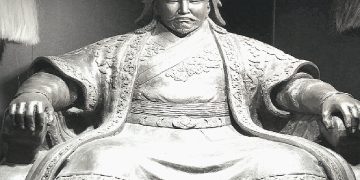Who are the Sumerians and Akkadians, and later the Babylonians and Assyrians
Even before the appearance of the Sumerians in Mesopotamia, there was a mysterious cultural community called the Ubeid culture in literature.
But usually the most ancient of the mentioned civilized peoples of Mesopotamia, the undisputed creators of the Mesopotamian writing, were the Sumerians, who settled in Lower Mesopotamia at the beginning of the 4th millennium BC. At the end of the 4th millennium BC. a special branch of the Semites, the so-called Eastern Semites, who received the name “Akkadians” in science, moved from Northern Arabia to Mesopotamia. One group of Eastern Semites settled in the north of the territory occupied by the Sumerians (the Sumerian name of this area is Ki-Uri), and another group settled on the Middle Tigris. From the first group of Eastern Semites, who mixed with the Sumerians and eventually assimilated them, the Babylonian people descended, from the second – the Assyrians. Babylonian and Assyrian languages are different dialects of the East Semitic (Akkadian) language, at the turn of the 3rd-2nd millennium BC. isolated from each other.
The emergence of “Akkadians”
At the end of the 3rd millennium BC. in Lower Mesopotamia a great power arose, covering the whole of Mesopotamia. Its capital was the city of Akkad, located in the Ki-Uri region. During this period, for the first time in official inscriptions, East Semitic began to be used along with the Sumerian language. As a result, the East Semitic language in Mesopotamia began to be called Akkadian, and modern scholars call its speakers Akkadians.
Community “blackheads”
The Sumerian-Akkadian-speaking population of Lower Mesopotamia (the ancestors of the Babylonians) and the Akkadian-speaking population of the Middle Tiger (the ancestors of the Assyrians) perceived themselves as a single bilingual superethnos. The people of this superethnos even had a common self-name: in both Sumerian and Akkadian languages they defined themselves as “black-headed” (in Sumerian – sang-ngiga, in Akkadian – tsalmat kakkadi). This super-ethnos is called by modern scientists “ancient Mesopotamians”, “carriers of the Mesopotamian civilization.” The community of “blackheads” distinguished itself not by a political criterion (they were not so often united within the borders of one power), but by a civilizational one. Members of communities and clans that supported the cult of the Sumerian-Akkadian deities and considered one of them to be their main community patron, who spoke Sumerian and Akkadian languages and used the Sumerian-Akkadian cuneiform script, belonged to the “blackheads”. Thus, the community of “blackheads” was an ethnocultural community in the modern sense of the word.
The importance that the Mesopotamians attached to their identification of “blackheads”, regardless of any political boundaries, is vividly illustrated by the example of the famous Laws of Hammurabi, who ruled all Mesopotamia. In the introduction to these Laws, Hammurabi declares himself the ruler and protector of the “blackheads”, after which he lists many cities under his control. However, as it turned out, this list does not include all the cities that were actually part of his empire, but only those that were inhabited by the Sumerian-Akkadians who supported the cults of the Sumerian-Akkadian gods indicated in this list next to each city named in it. Thus, within the entire circle of lands subject to him, Hammurabi singles out the Sumerian-Akkadian ethno-ritual area and only considers it as “his”, and does not even mention his other possessions.
Assimilation of the Sumerians by the Akkadians
The community of “blackheads” has come a long historical path. At the turn of the III-II millennium BC. e. Akkadians completely assimilated the Sumerians. However, the former division of the “blackheads” into Akkadians and Sumerians, as well as the division of Lower Mesopotamia itself into the Sumerian south and Akkadian north, did not pass without leaving a trace. The Sumerian language remained for all “blackheads” the “dead” language of learning and ritual. Lower Mesopotamia retained the name “Sumer and Akkad”, and the descendants of the inhabitants of the Sumerian south of Lower Mesopotamia were now regarded as a special people of the “Primorye” within the community of “blackheads”.
At about the same time, as already mentioned, the Akkadian-speaking population of Lower Mesopotamia separated in dialect from the Akkadian-speaking inhabitants of the Middle Tigris Valley with its center in Ashur. Soon this isolation was consolidated politically:
- Lower Mesopotamia united around Babylon,
- Ashur remained independent of him.
As a result, by the middle of the II millennium BC. e. the “blackheads” themselves have already divided themselves into three peoples:
- Assyrians,
- Akkadians (Babylonians)
- and Primorye – the descendants of the Sumerians of the extreme south of Mesopotamia, assimilated by the Akkadians.
In the next few centuries, the Primorians completely merged with the Babylonians, so that in the 1st millennium BC. it was already just about the Assyrians and Babylonians. The last traces of the former ethno-territorial difference between the Sumerian south and the Akkadian north of Lower Mesopotamia were finally erased and forgotten.
Making the “blackheads” into a community
Henceforth, if political fragmentation ensued in Mesopotamia, it was perceived as a temporary disaster; it was believed that as soon as the gods return their mercy to the country, it will reunite. The wars between different kingdoms of fragmented Mesopotamia and the change of political centers of the country were now understood not as the usual confrontation between different states, but as the transition of the single statehood of the kingdom of “Sumer-i-Akkad” from one dynasty to another. Since the 18th century. BC. and until the end of the Mesopotamian civilization the capital of the kingdom of “Sumer-i-Akkad” was almost invariably Babylon, therefore, speaking about the events of the middle of the 2nd-1st millennium BC, many authors call this kingdom Babylonia.Although the “blackheads” distinguished themselves into a community not on a political, but on an ethnocultural basis, later they nevertheless developed a special concept that shaped their already established unity politically and territorially. This concept was finally formed at the end of the 3rd millennium BC. under the kings of the III dynasty of Ur . Since that time, it was believed that the Sumerian-Akkadian area forms a solid territorial unity – the country “Sumer-i-Akkad”, which the gods themselves intended to exist under one rule, as a special kingdom.
The appearance of the Assyrians
Since the XIV century. BC. The perception of their history by the Mesopotamians was complicated by the fact that the Assyrian state appeared on the northern border of Sumer-i-Akkad (Babylonia): the city-state of Ashur united under its rule the vast territories of Upper Mesopotamia, thus turning into the capital of a powerful new kingdom. Assyria defined itself as a special geopolitical entity, separate from the “Sumer-i-Akkad”, but wanted to unite with it under the auspices of the Assyrian kings.
The Assyro-Babylonian wars, which did not stop for many centuries, caused by these claims, did not lead to any lasting results and ended only with the death of Assyria. During this time, the Assyrians tried many ways to keep Babylonia under their rule – from direct annexation to the creation of a special autonomous Babylonian kingdom as part of the Assyrian state (its throne was usually given to one of the Assyrian princes), but they could not achieve the submission of the Babylonians. In the end, Babylonia, rebelling against Assyria, destroyed it (the end of the 7th century BC) and for some time was the only state of the “blackheads”. In 539 BC. as a result of the Persian conquest, Mesopotamia became part of the Persian Empire.
Aramaic assimilation of “blackheads”
The ethnocultural community of “blackheads”, having lost its independent statehood, continued to exist for several more centuries. Its history ended with the Aramaic assimilation of the “blackheads”. The Arameans (the ancient “Syrians” as the Greeks called them; not to be confused with the modern Syrian Arabs) are one of the largest Semitic peoples of the ancient East, settled in Mesopotamia at the beginning of the 1st millennium BC. With the death of Assyria, a significant part of the Assyrian community was destroyed, and the rest began to rapidly Arameize. After the Persian annexation of Babylonia, its Akkadian-speaking population was also rather quickly assimilated by the Arameans, having lost their former language, writing, and many cultural values. By the end of the 1st millennium BC. only part of the population of the largest cities spoke Akkadian and performed Sumerian-Akkadian rituals. Around the turn of the eras, and she Arameized. Both of her languages, Sumerian and Akkadian, as well as her writing (cuneiform), finally fell out of use. Thus ended the history of the people of the “blackheads” and the civilization of ancient Mesopotamia.












